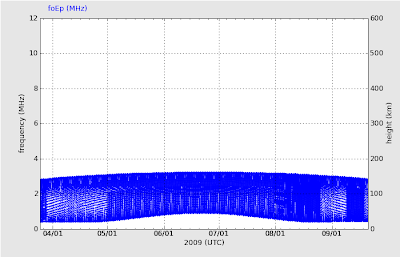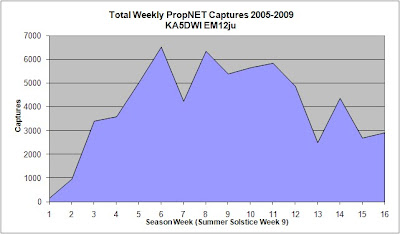.bmp)
.bmp)
Hello Again,
This will be my last post until next weekend. I have to go back to work (Spring Break). To recap, I have posted my 5 years of results by day of the season (4/25 to 8/14) and have also posted annual charts of Es Layer critical frequency to show the base cause for Es propagation.
I will now begin to post charts that show the characteristics of Es.
The first ones are the number of captures by local hour for the five years (2005-2009). The hourly order is displayed as sunrise to sunrise. During the season the sun rises during the 6 AM hour, is at solar noon at about 1:20 PM (13:20) and sets during the 8 PM (20:00) local hour. My local hour is Central Daylight Savings time.
The sunrise to sunrise display was selected to clearly show the Es are diurnal. Diurnal means the pattern is daytime active. For 10 Meter Es (I truly believe all frequencies), the most active period is in the morning hours from mid-morning till noon. There is a second peak around late afternoon but in three of the five years the mornings clearly show the most activity. Most believe that Es are evening active, but it is probably due to the number of Hams active later in the day.
One displays each of the five years and the overall average. The plots are based on a 3 hour average. Example, 6 AM is an average of 5, 6 and 7 AM. The second one is the actual number of captures for 5 years.
Again I will be unavailable most of the week. I will answer questions next weekend.
73's
Art KA5DWI
.bmp)
.bmp)
.bmp)
.bmp)
.bmp)






